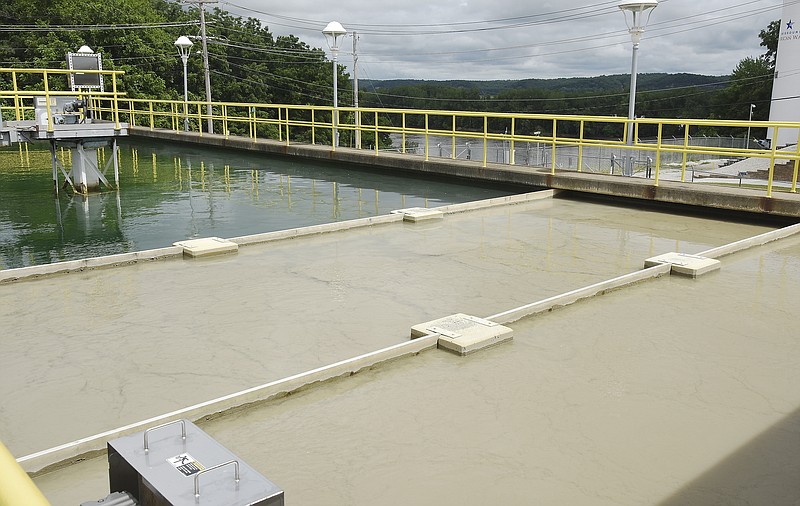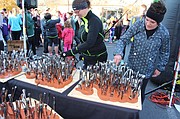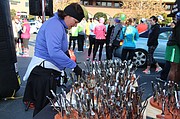When a faucet handle is turned, clear, clean water should pour out.
But that simple function requires a multitude of treatments and testing to ensure such a simple task produces clear, clean and consumable water.
Throughout the year, every year, public water suppliers work to ensure water is clean and contain minuscule amounts of contamination.
By July 1 every year, community water supplies must provide Consumer Confidence Reports, also called annual water quality reports, to customers, according to the Missouri Department of Natural Resources. The reports allow customers to review where their drinking water comes from, the contaminants found in the water, the source of the contaminants and other educational information.
"We want folks to know that it's safe and tested," said Todd Eichholz, section chief of the water monitoring section for DNR. "If you know it isn't or it fails, we can put pressure on the water system to correct it and fix the problem."
It may be reasonable to expect drinking water to contain small amounts of some contaminants, especially depending on the source of the water, according to the annual water quality reports. Drinking water can come from rivers, lakes, streams, ponds, reservoirs, springs and/or groundwater wells.
"As water travels over the surface of the land or through the ground, it dissolves naturally-occurring minerals and, in some cases, radioactive material, and can pick up substances resulting from the presence of animals or from human activity," according to the reports.
Water may contain microbial contaminants like viruses and bacteria, inorganic contaminants like salts and metals, pesticides and herbicides, and organic chemical and radioactive contaminants, the reports state. However, it's the public water supply districts' responsibilities to keep the contamination levels as low as possible.
Community water systems have certified operators that collect water samples for the annual water quality reports, Eichholz said. They then turn those samples over to DNR, he added.
Contaminates in the CCR were measured in parts per million (ppm), parts per billion (ppb) and picocuries per liter (pCi/L).
Certain contaminants are monitored less often than once a year since certain contaminants are not expected to vary significantly each year, according to the CCR.
Which contaminants are monitored yearly also depends on the source of water, Eichholz said. For example, a river is "a lot more vulnerable than a protected well" and is more likely to contract pesticides. So, surface water systems test for pesticides more regularly than water supply districts that get groundwater from wells.
Many contaminants like barium and fluoride have a maximum contaminant level - or the highest level of a contaminant allowed in drinking water.
Copper and lead have action levels, which is the concentration of a contaminant that, when it exceeds the number in more than 10 percent of its samples, the water system must follow specific treatments and other requirements, Eichholz said. That could include consumer education, increased sampling or hiring an engineer.
If sample results come back and the contaminant is above the action level or maximum contaminant level, Eichholz said, DNR and the water supply district must monitor the contaminant more regularly, usually quarterly. If it is still high, he added, DNR will send a violation to the water supply district and urge them to tell customers about the contamination levels.
"Hopefully the water system would abandon the well or put on treatment or connect to a nearby source voluntarily," he said. "if they chose not to, we can escalate enforcement to the attorney general's office. We have that right to ensure customers are provided safe water."
Eichholz encouraged customers to visit DNR's website to view the full annual water quality reports for public water districts in their areas.
"There is a lot of information at your fingertips and these water systems do a really good job," he said. "I think Missouri is blessed with water resources, and we have trained certified operators, and we are blessed with pretty good water here."
The News Tribune compiled the 2018 annual water quality reports for 12 public water suppliers in Cole County to better understand what contaminants are in the local drinking water.
Missouri American Water - Jefferson City
In 2016, of the 31 water samples in the Missouri American Water - Jefferson City distribution center, 90 percent of the water utility levels contained less than 0.09 ppm of copper, according to the district's 2018 annual water quality report. The action level for copper is 1.3 ppm, and none of the samples were above the level.
During the same year, of 31 water samples in the distribution center, 90 percent of the water utility levels contained less than 2 ppb of lead, according to the report. The action level for lead is 15 ppm, and none of the samples were above the level.
Copper and lead can come typically come from corrosion of household plumbing systems.
In 2018, the water leaving the treatment facility contained 0.4 ppb of antimony, which has a maximum contaminant level of 6 ppb, according to the report. Antimony typically comes from petroleum refineries' discharge, fire retardants, ceramics, electronics and solder, according to the report.
The water samples also contained 0.1 ppb of atrazine, which can come from runoff from herbicide used on row crops. The maximum contaminant level is 3 ppb, according to the report.
There was also 2.2-2.7 ppm of chloramine, a water additive used to control microbes, according to the report. It is a required process that's supposed to reduce the contamination level in drinking water, the report notes.
The water samples contained 0.6 ppm of fluoride, which has a maximum contaminant level of 4 ppm. Fluoride typically comes from natural deposits and water additive that promotes strong teeth, according to the report.
There was also 1.9 ppm of nitrate in water samples in 2018. The maximum contaminant level for nitrate is 10 ppm. Nitrate and nitrite can come from fertilizer runoff, sewage, natural deposits erosion and leaching from septic tanks.
In the 2018 water samples, there was 3 ppb of selenium, which typically comes from discharge from petroleum, metal refineries and mines, as well as erosion of natural deposits, the report states. The maximum contaminant level for selenium is 50 ppb.
Total organic carbon results ranged 2.1-3.3 ppm, according to the report. Organic carbon is naturally present in the environment and is a required process that's intended to reduce contamination in drinking water.
According to the CCR, none of the water samples in the distribution system in 2018 came back positive for E. coli, which typically comes from human and animal fecal waste.
Missouri American Water - Lake Carmel
In 2011, of the five water samples in the Missouri American Water - Lake Carmel distribution center, 90 percent of the water utility levels contained less than 0.157 ppm of copper, according to the district's 2018 annual water quality report. The action level for copper is 1.3 ppm, and none of the samples were above that level.
In the same year, of the five samples, 90 percent of the water utility levels contained less than 3.5 ppb of lead, the report states. The action level for lead is 15 ppb, and none of the samples were above that level.
In 2018, the water entering the distribution center contained 5.3 pCi/L of alpha emitters, which typically comes from natural deposits erosion, according to the report. The maximum contaminant level for alpha emitters in water samples is 15 pCi/L.
The water samples also contained 0.1 ppm of barium, which has a maximum contaminant level of 2 ppm, the report notes. Barium typically comes from discharge of drilling wastes and from metal refineries, as well as erosion of natural deposits.
Chlorine levels ranged 1.1-1.9 ppm in the 2018 water samples, according to the report. The substance is a required process that's intended to reduce contamination in drinking water, the report adds.
There was 0.2 ppm of fluoride in the water samples, the report notes. The substance has a maximum contaminant level of 4 ppm.
None of the water samples in the distribution system in 2018 came back positive for E. coli, according to the report.
Missouri American Water - Redfield Subdivision
In 2016, of the five water samples in the Missouri American Water - Redfield Subdivision distribution center, 90 percent of the water utility levels contained less than 0.283 ppm of copper, according to the district's 2018 annual water quality report. The action level for copper is 1.3 ppm, and none of the samples were above that level.
In the same year, of the five samples, 90 percent of the water utility levels contained less than 6 ppb of lead, according to the report. The action level for lead is 15 ppb, and none of the samples were above that level.
None of the water samples in the Missouri American Water - Red Field Subdivision distribution system in 2018 came back positive for E. coli, the report states.
In 2018, water samples entering the distribution system contained 0.1 ppm of barium, which has a maximum contaminant level of 2 ppm, the report states.
The water samples contained 0.1 ppm of fluoride, which has a maximum contaminant level of 4 ppm, according to the report.
The samples also contained 1.1-2.1 ppm of chlorine, which is a required process that's intended to reduce contamination in drinking water, the report adds.
The water samples also contained 6.5 pCi/L of gross alpha, which has a maximum contaminant level of 15 pCi/L, the report adds. This contaminant typically comes from the erosion of natural deposits.
Missouri American Water - Wardsville
In 2018, of the five water samples in the Missouri American Water - Wardsville distribution center, 90 percent of the water utility levels contained less than 0.118 ppm of copper, according to the district's 2018 annual water quality report. The action level for copper is 1.3 ppm, and none of the samples were above that level.
Lead was not detected in the water samples, the report notes.
None of the water samples in the Missouri American Water - Wardsville distribution system in 2018 came back positive for E. coli or coliform, according to the report.
Samples taken in 2017 from water entering the distribution system showed 1-2.1 ppm of chlorine, the report states.
There was also 0.4-0.41 ppm of nitrate in the 2018 water samples, according to the report. The maximum contaminant level for nitrate is 10 ppm.
Cole County Public Water Supply District 1
The Cole County PWSD1 water comes from groundwater wells on Rear Constitution, Henwick Lane, Rainbow Drive, London Way, Scruggs Station Road and Scott Station Road, according to the district's 2018 CCR.
The Cole County PWSD1 serves 6,500-6,600 customers, manager Ruth Winters said.
There were no violations at Cole County PWSD1 in 2018, the report notes.
From 2014-16, lead levels ranged 1.12-22 ppb, with 90 percent of the water utility levels being less than 6.88 ppb.
The action level for lead is 15 ppb, according to the report. Two samples at Cole County PWSD1 were higher than the action level, the CCR notes.
While there were two samples over the action level at Cole County PWSD1, Eichholz said, it was not more than 10 percent of its samples.
However, the Cole County PWSD1 included some information about lead in drinking water in its CCR. It states lead levels may be higher at one home than in other homes in the community due to the home's plumbing materials.
Those concerned about elevated lead levels in their homes' water can flush their tap for 30 seconds to two minutes before using tap water, the report suggests. Residents can also ask to have their water tested.
From 2014-16, copper levels ranged from 0.0165-0.229 ppm, with 90 percent of the water utility levels being less than 0.151 ppm, according to the report. The action level for copper is 1.3 ppm, and none of the samples were over the action level, the report notes.
Barium levels ranged from 0.0702-0.176 ppm when collected in March 2018, the report states. The maximum contaminant level for barium is 2 ppm.
Barium typically comes from discharge of drilling wastes and from metal refineries, as well as erosion of natural deposits.
Fluoride levels ranged 0.35-0.94 ppm when collected in February 2018, according to the report. The maximum contaminant level is 4 ppm for fluoride.
In February 2018, there was 0-0.011 ppm of nitrate and nitrite, according to the report. The maximum contaminant level for nitrate and nitrite is 10 ppm.
In September 2016, the combined radium -226 and -228 levels were 2.3 pCi/L, with the maximum contaminant level being 5 pCi/L, according to the report. This can come from erosion of natural deposits.
The gross alpha particle activity level was at 3.4 pCi/L in September 2o16, according to the report. The report does not list a maximum contaminant level for this contaminant, which typically comes from the erosion of natural deposits.
Winters said there aren't any underlying threats the Cole County PWSD1 worries about since it does regular water quality testing to ensure contamination levels are either low. She added the district was not impacted by recent flooding.
"The whole western side would have to flood to contaminate our entire system," she said. "If one well is in jeopardy, we can turn it off and not pump from it."
All of the district's wells would have to be compromised at once for the district to not service the area, which would be extremely rare, Winters said. If that were to happen though, she added, the water supply district is interconnected with Missouri American Water and has a partnership with Cole County Public Water Supply District 2.
Cole County Public Water Supply District 2
The Cole County PWSD2 water comes from groundwater wells on Southridge Drive, Vieth Drive, Schott Road, Christy Drive, Brazito Road, Herron Drive and Frog Hollow Road, according to the CCR. The district also has 5,178 service connections, manager Randy Kay said.
There were no violations at Cole County PWSD2 in 2018, the district's report notes.
Water samples from 2016-18 showed 1.04-25.4 ppb of lead, with 90 percent of the water utility levels being less than 4.51 ppb, according to the district's 2018 annual water quality report. One sample was over the action level of 15 ppb, it adds.
Water samples from those two years also showed 0.0282-0.226 ppm of copper, with 90 percent of the water utility levels being less than 0.1872 ppm, according to the report. The action level for copper is 1.3 ppm, and none of the samples were above that level, the report notes.
The water supply district had barium levels ranging 0.104-0.186 ppm when collected in February 2018, according to its 2018 annual water quality report. The maximum contaminant level for barium is 2 ppm.
There was 0.48-0.72 ppm of fluoride in water samples taken in February 2018, according to the report. The maximum contaminant level is 4 ppm.
In February 2018, there was 0-0.01 ppm of nitrate and nitrite in the water samples, according to the report. The maximum contaminant level is 10 ppm.
In May 2018, there was 0-0.00312 ppm of xylenes, which typically comes from discharge from petroleum and chemical factories, according to the report. The maximum contaminant level for xylenes is 10 ppm.
Combined radium -226 and -228 levels ranged 1.5-1.8 pCi/L when the district collected water samples in January 2015. The maximum contaminant level is 5 pCi/L.
The gross alpha particle activity in sampled water in April 2015 ranged 7.5-8 pCi/L according to the report. There is not a listed maximum contaminant level.
If the seven wells were compromised, Kay said, the systems are interconnected with Missouri American Water and the district could pull water from it.
The district was also not impacted by recent flooding, he added.
Cole County Public Water Supply District 3
The Cole County PWSD3 serves about 780 people, manager Sheryl Gillmore said. The Cole County PWSD3 water comes from groundwater wells, according to its 2018 annual water quality report.
There were no violations at Cole County PWSD3 in 2018, the report notes.
Between 2014-16, water samples contained 0.0267-0.212 ppm of copper, with 90 percent of the water utility levels being less than 0.192 ppm, according to the report. The action level is 1.3 ppm, and none of the samples were above that level.
During the same time frame, water samples contained 1.11-7.87 ppb of lead, with 90 percent of the water utility levels being less than 4.01 ppb, the report states. The action level is 15 ppb, and none of the samples were above that level.
In February 2018, water samples contained 0.104-0.131 ppm of barium, which has a maximum contaminant level of 2 ppm, the report states.
During that same month, water samples had 0.18-0.25 ppm of fluoride, which has a maximum contaminant level of 4 ppm, according to the report.
The water sample in June 2015 contained 1.2 pCi/L of combined radium -226 and -228, which has a maximum contaminant level of 5 pCi/L.
There was 4.8 pCi/L of gross alpha particle activity in the water sample that same month, according to the report. That report does not list a maximum contaminant level.
While there are safeguards to protect the two wells, Gillmore said, if something were to happen and the district needed backup water, it has an agreement with Cole County PWSD1.
The district was not impacted by flooding, she said.
Cole County Public Water Supply District 4
The Cole County PWSD4 gets water from groundwater wells on West Drive, Route M, Forest Hill Drive and North Boundary Road, according to the district's 2018 annual water quality report. The district also serves 1,275 meters that it serves, manager Will Humphrey said.
There were no violations at Cole County PWSD4 in 2018, the CCR notes.
Between 2016-18, water samples contained 0.015-0.307 ppm of copper, with 90 percent of water utility levels being less than 0.181 ppm, according to the district's 2018 annual water quality report. The action level for copper is 1.3 ppm, and none of the samples were above that level, the report notes.
During that same time frame, water samples contained 1.02-47.8 ppb of lead, with 90 percent of the water utility levels being less than 13.7 percent, the report states. The action level for lead is 15 ppb, and two samples were above that level, according to that report.
In February 2018, water samples contained 0.0755-0.132 ppm of barium, which has a maximum contaminant level of 2 ppm, according to the report.
Also that month, water samples contained 0.56-0.69 ppm of fluoride, which has a maximum contaminant level of 4 ppm, the report states.
In June 2018, water samples contained 0-0.00162 ppm of xylenes, which has a maximum contaminant level of 10 ppm, according to the report.
Water samples in February 2018 contained 1.1-2.5 pCi/L of radium -226 and -228, which has a maximum contaminant level of 5 pCi/L, according to the report.
The samples also contained 4.5-9.4 pCi/L of gross alpha particle activity. The report does not list a maximum contaminant level.
The district has two different pressure zones that contain two wells each, Humphrey said, so the district believes there is enough of a backup in case one of the wells became contaminated.
While the district itself was not impacted by flooding, Humphrey said, several of its customers were.
Cole County Public Water Supply District 5
The Cole County PWSD5 gets water from groundwater wells, according to the district's 2018 annual water quality report.
There were no violations at Cole County PWSD5 in 2018, the report notes.
In December, four water samples were positive for coliform, which is a bacteria naturally present in the environment, according to the report. Coliforms are used to indicate whether they may be other potentially harmful waterborne pathogens or if there is a possible pathway that contaminates could enter the distribution center, the report adds.
The report states there were more assessments conducted to identify why coliform bacteria is in the water, and the PWSD5 was required to take zero corrective actions.
Between 2015-17, water samples contained 0.00861-0.145 ppm of copper, with 90 percent of the water utility levels being less than 0.1385 ppm, according to the report. The action level for copper is 1.3 ppm, and none of the water samples were over the action level.
During the same two years, the water samples contained 1.12-1.99 ppb of lead, with 90 percent of the water utility levels being less than 1.89 ppb, according to the report. The action level for lead is 15 ppb, and none of the sites were above the action level.
In February 2018, there was 0.152 ppm of barium in the water sample, the report states. The maximum contaminant level for barium is 2 ppm.
Russellville Public Water Supply
The Russellville Public Water Supply receives water from groundwater wells, according to the CRR. Russellville owns the public drinking water and wastewater systems and has 337 connections, said James McCoy, the lead operator for People Services, with whom the city contracts.
There were no violations at the water supply district in 2018, the district's annual water quality report states.
Between 2014-16, there was 0.0421-0.221 ppm of copper in the water samples, with 90 percent of the water utility levels being less than 0.169 ppm, the report states. The action level for copper is 1.3 ppm, and none of the sites were above that level.
During the same time frame, there was 1.15-3.11 ppb of lead, with 90 percent of the water utility levels being less than 1.53 ppb, according to the report. The action level for lead is 15 ppb, and none of the sites were over the level.
In January 2018, there was 0.237-0.349 ppm of barium in the water samples. The maximum contaminant level for barium is 2 ppm.
That same month, there was 1.05-1.34 ppb of chromium in the water samples, the report states. The maximum contaminant level for chromium is 100 ppb.
Chromium typically comes from discharge from steel and pulp mills, according to the report.
In January 2017, there was 0-2.3 pCi/L of radium -226 and -228 in the water samples, the report states. The maximum contaminant level is 5 pCi/L.
There was also 3.5-6.4 pCi/L of gross alpha particle activity, according to the report. The report does not list a maximum contaminant level.
There was one sample in November that came back positive for coliform, which is naturally present in the environment, according to the report.
The district was not impacted by flooding, McCoy said. If the water system was compromised, he added, they would offer bottled water and have water transported in to customers.
Eugene Public Water Supply
The Eugene Public Water Supply gets water from groundwater wells, according to its 2018 annual water quality report.
There was one violation on its report regarding E. coli. The compliance period ran in March 2018, the report notes.
Between 2015-17, there was 0.0713-0.105 ppm of copper in the water samples, with 90 percent of the water utility levels being less than 0.1035 ppm, according to the report. The action level for copper is 1.3 ppm, and none of the samples were over the action level.
During the same time frame, there was 1.46-1.72 ppb of lead in the water samples, with 90 percent of the water utility levels being less than 1.59 ppb, according to the report. The action level for lead is 15 ppb, and none of the samples were over the action level.
In January 2018, there was 0.165-0.244 ppm of barium in the water samples, according to the report. Barium has a maximum contaminant level of 2 ppm.
In February 2018, there was 0-0.64 ppb of cadmium in the water samples, according to the report. The maximum contaminant level for cadmium is 5 ppb.
Cadmium typically comes from galvanized pipe corrosion, natural deposit erosion, metal refineries discharge and waste batteries and paint runoff.
Centertown Public Water Supply
The Centertown Public Water Supply gets water from groundwater pump house on Broadway Street, according to its 2018 annual water quality report.
There were no violations in 2018, according to the report.
Between 2014-16, water samples contained 0.0356-0.13 ppm of copper, with 90 percent of the water utility levels being less than 0.118 ppm, according to the report. The action level for copper is 1.3 ppm, and none of the sites were over that level.
During the same time frame, water samples contained 2.29-3.1 ppb of lead, with 90 percent of the water utility levels being less than 3.1 ppb, according to the report. The action level for lead is 15 ppb, and none of the sites were over that level.
In 2018, water samples contained 0.384 ppm of barium, which has a maximum contaminant level of 2 ppm, according to the report.
In 2015, radium -226 and -228 levels were at 2.8 pCi/L, the report notes. The maximum contaminant level for those contaminants combined is 5 pCi/L.
Also in 2015, water samples contained 5.1 pCi/L of gross alpha particle activity, the report states. The report did not list a maximum contaminant level.









